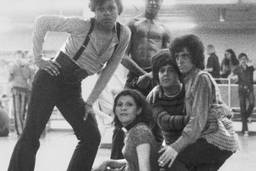
By the time I.F. “Izzy” Stone died in May 1989 at age 82, he had transformed from America’s premier radical journalist into a respectable icon of his profession. His passing was carried on all four major television networks. On ABC, Peter Jennings hailed him as “a journalist’s journalist” and, citing Stone’s credo – “To write the truth, to defend the weak against the strong, to fight for justice” – proclaimed it “a rich experience to read or reread Stone’s views on America’s place in the world.” His obituary was featured on the front pages of the New York Times, which called him “an iconoclast of journalism,” the Washington Post (“a dogged investigator and a concise and clever writer”), the Los Angeles Times (“the conscience of investigative journalism”), and the Philadelphia Inquirer (“Like Sunday doubleheaders and the five-cent cigar, I.F. Stone was an American institution”).
But three and a half decades earlier, at the height of the domestic Cold War and McCarthyism, not a single daily newspaper dared to run Stone’s byline. He wrote in his own newly-founded newsletter I.F. Stone’s Weekly: “Early Soviet novels used a vivid phrase, ‘former people,’ about the remnants of the dispossessed ruling class. On the inhospitable streets of Washington these days, your editor often feels like one of the ‘former people.’ ” A fixture on “Meet the Press” from its inception in 1946 until 1949, he suddenly disappeared, not to be seen again on national television for 18 years. Yet Stone’s flattering obituaries universally ignored the real reasons that had long made him a pariah. As D.D. Guttenplan notes in his new biography, American Radical: The Life and Times of I.F. Stone, “Only John R. MacArthur, writing in the socialist weekly In These Times, hinted at the reasons for Stone’s long isolation or the threat he posed to mainstream journalism when he was still alive and reporting news that his newfound acolytes wouldn’t even recognize as news.”
American Radical is the third biography of Stone to appear since his death – and the best. Guttenplan’s book, 15 years in the making and more exhaustively researched than the previous efforts, is based on archival material not previously consulted and 130 fresh interviews with people who knew Stone (including yours truly). And Guttenplan is more profoundly in sympathy with the radicalism that animated Stone. But this is no uncritical hagiography. Guttenplan presents Stone as he was – warts and all. He could be difficult, caustic and cutting with colleagues, friends and even his own family. His impatient irritability increased when he became nearly deaf in his late thirties and was forced to use the imperfect hearing aids of the period (which he sometimes used to good effect for investigative eavesdropping).
Guttenplan, in felicitous, colorful and evocative prose, restores Stone in all his rambunctious glory as a superlative journalistic insurrectionary, an “irritant to power – for his uncanny ability to seize on the most inconvenient truths and for his vociferous opposition to the existing order.” To Stone, journalism was activism. In the 1930s and 1940s, he was a player in the corridors of power, deeply involved in what Oliver Wendell Holmes called “the passion and action of our times.”
Born Isadore Feinstein in 1907, the first-generation son of Yiddish-speaking immigrant parents, Stone was tapped as a protégé by the liberal publisher of the Camden Courrier, J. David Stern, who made him a reporter during his senior year of high school. But when the city editor refused his request to go to Boston to cover the 1927 executions of anarchists Sacco and Vanzetti, Stone, already a self-educated radical, quit the paper in a fit of pique and hitchhiked to Boston on his own. After a brief stint at the Philadelphia Inquirer, Stone was lured back to Stern’s Courrier to become a theater and film critic.
Guttenplan chronicles the ups and downs of Stone’s career and his blending of journalism and politics, calling him a “one-man united front.” At the height of the Great Depression, Stone put his personal, crusading stamp on the pro-New Deal editorial page of the New York Post as chief editorial writer, and was also a star muckraker for The Nation.
But he was also an active part of the New Deal’s left wing. Brash, radical, anti-fascist and pro-labor, Stone was an intimate of “Tommy the Cork” Corcoran (FDR’s political fixer), lunched regularly with Felix Frankfurter (FDR’s talent spotter who recruited bright young men for the administration), and got exclusive leaks for investigative stories from pugnacious populist Harold Ickes (FDR’s secretary of the interior and political warhorse). His political memos even wound up on Roosevelt’s desk. As Guttenplan puts it, Stone “rode into battle not as a paladin of the powerless or a gadfly, but as an insider, a confidential agent of the [left-wing] ‘party within a party’ that served the president’s purposes.”
Never a blind follower, Stone criticized Roosevelt’s compromises as The Nation’s first Washington correspondent in the early 1940s and later broke with Truman, supporting Henry Wallace’s 1948 presidential bid despite his disdain for Wallace’s Communist-supported Progressive Party. Guttenplan traces Stone’s complicated and nuanced relationship with the Communist Party and its members with political sophistication.
After stints at the progressive-radical daily New York newspaper PM (which epitomized Popular Front politics), the short-lived New York Star and the Daily Compass, Stone ran into the juggernaut of a United States increasingly “gripped by an ice-age of fear and political paralysis” as anti-Communism fervor fermented. Though he’d never been a member of the Communist Party, when the Compass folded in 1952, Stone, now 44, found himself unemployable. Even The Nation gave him the cold shoulder. “I feel for the moment like a ghost,” he wrote. So in 1953, he launched his own newsletter, I.F. Stone’s Weekly.
Guttenplan recreates the Popular Front climate in which Stone came to political maturity and prominence, and paints the domestic paranoia of the Red Scare that made him an outcast. For five years Stone was the subject of a full-scale FBI investigation of accusations he was a Soviet spy. He was followed everywhere. His phone was tapped. And all his mail was intercepted, which meant every subscriber to I.F. Stone’s Weekly got her or his name on the FBI’s lists. Guttenplan demolishes the absurd pretense that Stone was a KGB agent, a smear that still circulates on the hard right.
Guttenplan seems to have read every one of the 3.5 million words Stone wrote during the 19 years of the Weekly’s existence, and he does a masterful job of tracing the history of its many scoops and crusades, in addition to chronicling Stone’s life. The Weekly became a key element in the political education of the new generation of ’60s leftists, providing the anti-Vietnam War movement with the information it needed for its 15-year fight. By 1970, when Stone received a special George Polk Award in journalism, his rehabilitation was complete. American Radical is the must-read story of the loneliness of the long-distance runner, a story of unimaginable courage, stamina and a stubborn refusal to let the bastards wear you down.







